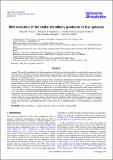Por favor, use este identificador para citar o enlazar a este item:
http://hdl.handle.net/10261/167385COMPARTIR / EXPORTAR:
 SHARE SHARE
 CORE
BASE CORE
BASE
|
|
| Visualizar otros formatos: MARC | Dublin Core | RDF | ORE | MODS | METS | DIDL | DATACITE | |

| Título: | Mild evolution of the stellar metallicity gradients of disc galaxies |
Autor: | Tissera, P.B; MacHado, R.E.G; Vílchez Medina, José Manuel CSIC ORCID; Pedrosa, S.E; Sanchez-Blazquez, P; Varela, S. | Palabras clave: | Galaxies: ISM Galaxies: evolution Galaxies: formation Galaxies: abundances |
Fecha de publicación: | 2017 | Editor: | EDP Sciences | Citación: | Astronomy and Astrophysics 604: A118 (2017) | Resumen: | The metallicity gradients of the stellar populations in disc galaxies and their evolution store relevant information on the disc formation history and on those processes which could mix stars a posteriori, such as migration, bars and/or galaxy-galaxy interactions. Aims. We aim to investigate the evolution of the metallicity gradients of the whole stellar populations in disc components of simulated galaxies in a cosmological context. Methods. We analyse simulated disc galaxies selected from a cosmological hydrodynamical simulation that includes chemical evolution and a physically motivated supernova feedback capable of driving mass-loaded galactic winds. Results. We detect a mild evolution with redshift in the metallicity slopes of-0.02 ± 0.01 dex kpc-1 from z ~ 1. If the metallicity profiles are normalised by the effective radius of the stellar disc, the slopes show no clear evolution for z< 1, with a median value of approximately-0.23 dex reff -1. As a function of stellar mass, we find that metallicity gradients steepen for stellar masses smaller than ~1010.3M· while the trend reverses for higher stellar masses, in the redshift range z = [0,1]. Galaxies with small stellar masses have discs with larger reff and flatter metallicity gradients than expected. We detect migration albeit weaker than in previous works. Conclusions. Our stellar discs show a mild evolution of the stellar metallicity slopes up to z ~ 1, which is well-matched by the evolution calculated archeologically from the abundance distributions of mono-age stellar populations at z ~ 0. The dispersion in the relations allows for stronger individual evolutions. Overall, supernova feedback could explain the trends but an impact of migration can not be totally discarded. Galaxy-galaxy interactions or small satellite accretions can also contribute to modify the metallicity profiles in the outer parts. Disentangling the effects of these processes for individual galaxies is still a challenge in a cosmological context. © 2017 ESO. | URI: | http://hdl.handle.net/10261/167385 | DOI: | 10.1051/0004-6361/201628915 | Identificadores: | doi: 10.1051/0004-6361/201628915 issn: 1432-0746 |
| Aparece en las colecciones: | (IAA) Artículos |
Ficheros en este ítem:
| Fichero | Descripción | Tamaño | Formato | |
|---|---|---|---|---|
| IAA_2017_aa28915-16.pdf | 1,2 MB | Adobe PDF |  Visualizar/Abrir |
CORE Recommender
SCOPUSTM
Citations
11
checked on 06-abr-2024
WEB OF SCIENCETM
Citations
9
checked on 29-feb-2024
Page view(s)
228
checked on 22-abr-2024
Download(s)
171
checked on 22-abr-2024
Google ScholarTM
Check
Altmetric
Altmetric
NOTA: Los ítems de Digital.CSIC están protegidos por copyright, con todos los derechos reservados, a menos que se indique lo contrario.
